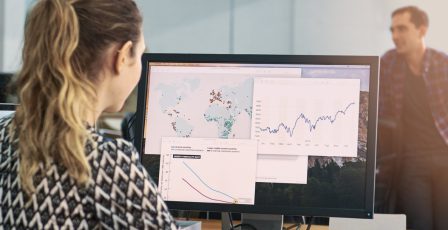Ask the Expert: Mobility data with Visitor Insights
Ask the Expert: A Q&A series with AdTech and data intelligence experts
In our ongoing ‘Ask the Expert’ Q&A series, we bring you insights from industry leaders who explore topics that are central to modern marketers. In today’s data-driven landscape, gaining a competitive edge often boils down to understanding consumer behaviour and making informed decisions. One valuable resource that has been gaining prominence is mobility data.
In this Q&A interview, Debbie Oates, Director of Customer Engagement at Experian Marketing Services is joined by Isabelle Hease, CEO at the UK’s leading geolocation data platform, Visitor Insights. Together, they guide us through an engaging discussion on how mobility data can be strategically employed to drive better business and marketing strategies.
Introducing mobility data and insights
Imagine having access to dynamic insights into human behaviour and how people interact with places and spaces. Mobility data provides just that. It involves gathering GPS signals emitted by personal handheld devices, primarily mobile phones, which triangulate the device’s location. These location coordinates, along with timestamps, offer a detailed picture of human movement across specific regions, such as the UK.
The power of mobility data lies in the ability to extract insights about where people go, what they prefer, their social interactions, weekend activities, evening outings, and even work locations. All this information can be harnessed to make critical commercial decisions and shape effective marketing strategies.
Privacy concerns addressed
One of the most critical aspects of handling mobility data is ensuring privacy. Isabelle emphasises that maintaining device anonymity is their top priority. The focus is not on tracking individual actions but on identifying trends and patterns that can help businesses make informed decisions. Additionally, all the data collected is entirely consent-based via mobile apps, adhering to GDPR anonymity standards.
Changing consumer behaviours
The COVID-19 pandemic dramatically altered the way people interacted with their local areas and businesses. It accelerated existing trends and introduced new ones. Isabelle points out some significant shifts, such as the rise in remote work, increased local tourism, and changing patterns of consumer behaviours.
Adapting to new realities
Businesses that want to thrive in this evolving landscape must adapt to these changes. Isabelle highlights that understanding these shifts requires both macro and micro-level insights. Mobility data provides quick access to macro-level insights, allowing businesses to benchmark locations against each other. However, understanding granular performance at a localised level is equally crucial.
Examples of mobility data in action
Isabelle shares examples of how Visitor Insights helps clients navigate changing visitor profiles. The trend of remote work led to a decline in city centre visitors, affecting businesses catering to professionals. However, this shift created opportunities in local communities as visitors spent more time in their neighbourhoods. Understanding where these visitors spend time is essential for businesses to adapt and capture spending.
Another interesting observation was the emergence of younger populations and families spending more time in city centres. This change in visitor demographics requires businesses to pivot their strategies accordingly. It highlights the importance of continually monitoring and adapting to changing trends.
More than footfall data – Combining demographics with mobility data
Isabelle highlights the difference between footfall data to mobility data as the latter deliver information on movement patterns over time as well as dwell times. Additionally, to gain a comprehensive understanding of existing and potential customers, combining demographic data with mobility data is key. Demographics provide insights into who the visitors are, allowing businesses to tailor their strategies effectively. Businesses can optimise their physical locations and marketing efforts further.
Using mobility data for marketing
Beyond occupancy and location planning, mobility data can play a pivotal role in marketing. Businesses can use this data to plan marketing campaigns and measure their impact effectively. By targeting specific geographies and understanding how different demographics interact with advertising efforts, companies can refine their marketing strategies.
3 tips for businesses exploring mobility data
Isabelle offered valuable advice for businesses considering the adoption of mobility data:
- Granularity of data: Seek data that provides detailed insights into visitor behaviour at different times of the day and week. The ability to disaggregate data is crucial for making effective decisions.
- Privacy compliance: Ensure that data collection is consent-based and adheres to privacy regulations like GDPR.
- Flexibility and adaptation: Be prepared to adapt your strategies in response to changing consumer behaviours and demographics.
In conclusion, mobility data is a powerful tool that businesses can leverage to make informed decisions and enhance their marketing strategies. It provides valuable insights into not only where people go but also who they are and how they behave. As the world continues to change, mobility data will become increasingly essential for staying competitive and relevant in the marketplace.
How Experian and Visitor Insights work together
Experian and Visitor Insights have joined forces to offer an unparalleled solution which combines the rich insight of Mosaic consumer classification with geolocation and mobility data. Granular demographic insights from macro-catchment definitions to micro geofenced areas enables a stronger understanding of mobility and footfall.
Accessed via self-serve platform Terain or on a project basis, identifying target audience patterns overtime, this unique geo-based intelligence empowers property professionals to strategically grow.
Welcome, everyone to our series, Ask The Expert, where I’ll be talking to industry experts around the use of data and insight and how people can utilise it to drive better business and marketing decisions. I’m joined today by Isabelle Hease, CEO of Visitor Insights. We’re going to be exploring how mobility data can drive better business and marketing decisions. Welcome, Isabelle.
Hi, Debbie.
Can you tell me a little bit about your role and how you use mobility data at Visitor Insights?
Absolutely. So, I head up Visitor Insights, or VI for short. We’re a mobility data insights company, so, effectively, we provide businesses with up-to-date insights around human behaviour and how people interact with place and space, so they can make better commercial decisions and apply those insights to their marketing initiatives.
Excellent. That’s really interesting. And in terms of mobility data, can you, just for those that are new to it, just explain a little bit more about that?
Effectively, mobility data is the gathering of GPS signals emitted through personal handheld devices. So, predominantly mobile phones that are triangulating that device’s location to a GPS. We then gather those location coordinates and a timestamp. And what that gives us is a really detailed picture of human movement across the UK and then from that, we can harness insights into human behaviours. So, where people have been, what their preferences are, what they like to do in terms of social interactions, where they go at the weekend, in the evening, where they work. And all of that can be used for commercial decision-making or marketing strategies.
I suppose out in the industry at the moment, then, quite rightly so, there’s a really big focus on consumer privacy. How do Visitor Insights approach this with the mobility data that you’re utilising?
So when we talk about, obviously, understanding movements that are attributed to people’s devices, it’s really important for us to ensure that that device remains absolutely anonymous. So, we’re not looking at what an individual is doing, really, we’re looking at trends and patterns. So, what are the correlations we’re seeing between how people interact with certain locations? Secondly, when we think about mobility data, obviously, we are collecting information around where people have been, so it’s incredibly important that all the data that we gather and we analyse in our systems is entirely consent based. So every single device that we have in our data set have opted in and that is a way that we ensure absolute privacy of the devices and obviously, adherence to GDPR anonymity.
And in terms of what we’re seeing play out in the market at the moment, then, consumer behaviour and the way that we interact with places, spaces is really changing and has done. What sort of challenges is that bringing to people? How are you seeing that play out?
I think we were seeing some quite significant changes in terms of how people were interacting with their local areas, how they’re interacting with retail. In a pre-pandemic environment, obviously, that was brought about by modern advances in technology, the internet, but actually, the pandemic really accelerated and changed some of those patterns in a pretty significant way. So we’re seeing a huge shift in terms of how people interact with their work. So, a huge trend towards working from home. A big shift in terms of local tourism. So, people are actually spending a lot more time in the UK on holiday as opposed to going abroad. And all of that has a massive impact in terms of how people interact with different places, how they go about their daily lives and all of that really impacts what we’re seeing on the ground. So, physical occupancy, but equally, the way that we market and we advertise to those visitors and those consumers.
I suppose, if I’m a business and I’m trying to grapple with understanding how my consumer base has shifted and what that means for my organisation, how are people utilising the insights that you have to enable them to make more robust decisions?
So, I think it’s really important to get a rounded view of how behaviours are shifting to utilise both macro and micro insights. So, mobility data can help in the way that it enables very fast access to macro-level insights. So, at the click of a button, you can understand how locations are performing and benchmark them against each other. But then really to understand that granular performance at a localised level, mobility data can also help by providing very granular insights in terms of how shifts have happened on a very small location basis. So, how has my street changed where I have a business? How has that really impacted my product line or my strategy at that localised level? That’s really important to do on a pretty regular basis, so, having up-to-date information. But I think historically and traditionally, the industry has tended to look at that historic data set to understand patterns and to predict the future. But I think ever increasingly, as we’re seeing such a quick shift in terms of behaviours on a relatively small timeline, that present data is really important to predict future trends. And I think that’s where we’re seeing a bit more of a shift in terms of data adoption is forecasting, trying to model the future to make better business decisions. In terms of adoption within different sectors, are you seeing that any particular sector is leading the charge in terms of this? Or is it right across sector? So, I think there are some really clear use cases for mobility data in a couple of sectors. And those are the occupier sector, marketing & advertising and real estate. So that’s where there is probably a bit more adoption of mobility data than in others. However, we are seeing quite a clear shift in terms of some businesses finding new use cases for mobility data. So we’re seeing a couple of companies that are really at the forefront of trying to understand their consumers, trying to understand their visitors. And it’s those businesses that we’re seeing that are actually cross-sector that are really sort of leading the charge in terms of adopting more data into their day-to-day activities.
And in terms of, you know, footfall, so we’ll talk about footfall a little bit, but also the fact that just having people passing particularly areas doesn’t necessarily give businesses the true picture. Because, actually, it’s also around how demographics are shifting in different ways and how they’re relating to space and place and being able to really understand that. With the work that we are doing together, then, how are you seeing the demographic shifts play out?
So, just to touch on the point that you made around footfall. I think it’s a really important one. So, we did historically see quite a lot of businesses adopt mobility data as a replacement to their footfall solution. And while it can provide an insight into visits and footfall, really, that’s not what mobility data is here to provide businesses with. It’s more about insights into human behaviours, how people are interacting with those places, not necessarily just the volumes of visits that are being made. So it’s about exploring all of those additional insights that mobility data can provide you. Mobility data, however, gives you a really good picture into how people visit a place, what they do when they’re there, where they’ve come from. But it really misses that important element of who. And the addition of demographic data into mobility data provides that rounded picture, so you can understand where people have been, why they’ve gone to a location, but actually, importantly, who they are. Who are those profiles of people that are visiting a certain place? And then obviously, how you construct strategies around that understanding of that visit.
Do you have any examples of where you are utilising the data with clients that you’re dealing with at the moment?
One of the trends that we’re observing at the moment is that pretty significant shift in city centre-type visitors as a result of the working-from-home trend. So, typically, we were seeing a visitor profile that was pretty heavily skewed towards a working professional who were visiting city centres on a five-day-a-week basis to come in for work. Since we’ve seen a lot more of the working-from-home pattern emerging, we are obviously seeing a big decline in terms of those types of visitors, up to 45% in some locations.
What that means for the businesses that cater for those professionals is obviously a decline in footfall, decline in profitability. However, we’re seeing those visitors actually spend a lot more time in their local communities and their local areas. And there still is demand for those types of businesses, those types of services, but in a different location. So those businesses really need to understand where their visitors are spending their time and as a result, reassess where they are spending their efforts, where they are focusing on their location planning in order to ensure that they’re still capturing spend from those types of visitor, but might be doing so in different locations. One of the really interesting things that we are seeing in the city centres though is we are seeing an emerging trend actually in families spending a lot more time in city centres. We’re seeing an increase in a younger population of visitor to city centres. And obviously, we need businesses to cater for that new visitor. So actually, the tenants that we’re seeing in city centres and the focus, in terms of who the businesses are catering to, have shifted really drastically in a three-year period. So it’s really important for occupiers or those building strategies around location planning, to have their finger on the pulse in terms of what’s happening in certain locations and understand where the pockets of opportunities lie.
And I think that really strongly demonstrates the power of the two pieces of information – the demographics, the mobility together. And actually, if we think about it, it’s not just kind of the occupier space. Within the conversations that I’m having with clients around actually how they plan marketing activity and the types of out-of-home type campaigns that they’re running and where they’re running them, all the way through to measurement as well. They’re running particular campaigns in particular geographies. Actually what impact is it having? Is it impacting the right target audience?
You can see that this is where this kind of starts to merge between the insights that you’re seeing traditionally from a location perspective into the marketing arena as well. I think it’s going to be a really exciting time as people really start to uncover the power of the data here as well.
Yeah, definitely. I think through the conversation that we’ve had, then, it’s quite apparent the real power of the information that you’ve got and how it can really support businesses to better cater, better understand consumers, as well as make more robust decisions. If the people out there that are looking at exploring mobility data, maybe for the first time, then have you got any advice that you can give them in terms of considerations?
I think I’d probably focus on three key pieces of advice. The first being granularity of the data. So, in order to make those actually, macro- and micro-level decisions, it’s really important to have a full picture in terms of how people are interacting with a place on a relatively detailed level. So, whilst we can look at footfall on an hourly basis, on a daily basis, a lot of other metrics are just viewed on a bit of an aggregate perspective. It’s really important to be able to disaggregate some of that insight. So if you are running a marketing campaign or you are an occupier, your visitors at different times of the day and different days of the week and how they behave is really important to how you promote yourself and actually, how you position yourself to those visitors. So, that granularity in terms of the numbers of metrics available and the way that you can break down the data is really going to be key to how you can actually apply those insights to commercial decision-making. Secondly, you’re bringing a new data set into your decision-making. It’s really important that you align yourself with a business that understands how you’ll use that data commercially and can support you in the applications of those insights into those strategies that you use the data for. And thirdly, I’d encourage businesses to really think outside of the box in terms of how they can use data and how they can apply that across their business. So we’ve seen some really interesting ways that people are using data, from, obviously, that site-selection piece, location planning, marketing. And then actually in terms of their internal operation. So from an HR perspective, really understanding your workers and how you can shape polices to support them in a better way. So that’s just one of the ways that businesses are being creative with their use of data. So I’d really encourage them to question how they can use the data in the best possible way. And then obviously, do that across as many areas of the business as possible.
That’s really great advice and I think, yeah, just exploiting that insight right across the organisation is key, really. Just, enough value in the location side, but actually, out into wider areas as well.
Really strong. Thank you very much.
I, myself, have found the conversation very interesting. I hope that everybody else has. Hopefully, we’ve given people something to think about just in terms of the use of mobility data and how it can really start to open up a wider perspective on how to engage consumers more effectively.
Thank you for joining me.
Thank you, Debbie, it’s been a pleasure.
If you want to find out more about how people are utilising data and insight to drive better business and marketing decisions then keep an eye out for more in our Ask The Expert series.










